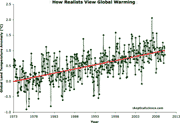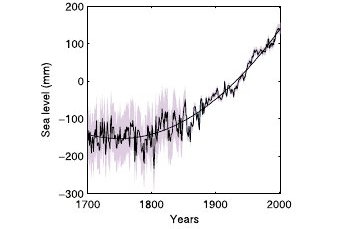Fact brief - Is sea level rise exaggerated?
Posted on 15 February 2025 by Sue Bin Park
![]() Skeptical Science is partnering with Gigafact to produce fact briefs — bite-sized fact checks of trending claims. You can submit claims you think need checking via the tipline.
Skeptical Science is partnering with Gigafact to produce fact briefs — bite-sized fact checks of trending claims. You can submit claims you think need checking via the tipline.
Is sea level rise exaggerated?
 Sea levels are rising at an accelerating rate, not stagnating or decreasing.
Sea levels are rising at an accelerating rate, not stagnating or decreasing.
Warming global temperatures cause land ice to melt and oceans to thermally expand, elevating sea levels. Since 1880, they’ve risen an estimated 8-9 inches (over 20 cm) based on historical data from coastal tide gauge stations.
In the 1990s, scientists began using satellites to measure sea levels. Since 1993, the global average sea level has risen 4 inches (10 cm).
These satellites send pulses to the ocean and measure the time it takes for the signal to return. Researchers account for factors like land height, resulting in highly accurate measurements with error margins of 1 millimeter. Short-term dips don’t contradict the overall rise, which is exceeding prior predictions.
Sea level rise has already submerged islands and atolls in places like The Solomon Islands and The Marshall Islands, while coasts worldwide have experienced flooding, infrastructure damage, and land loss.
Go to full rebuttal on Skeptical Science or to the fact brief on Gigafact
This fact brief is responsive to quotes such as the one highlighted here.
Sources
Woods Hole Oceanographic Institution Is sea-level rise exaggerated?
NASA Sea Level
IPCC AR6: Changes in global mean sea level
NOAA Is sea level rising?
About fact briefs published on Gigafact
Fact briefs are short, credibly sourced summaries that offer “yes/no” answers in response to claims found online. They rely on publicly available, often primary source data and documents. Fact briefs are created by contributors to Gigafact — a nonprofit project looking to expand participation in fact-checking and protect the democratic process. See all of our published fact briefs here.































 Arguments
Arguments
































If we
[snip]
are the only reason sea levels are rising, please explain:
![Sea Levels vs Emissions Global mean sea level anomalies (mm; blue) and carbon emitted (millions of tonnes; red) since the early 19th century. Reproduced from Fig. 4.1 of Curry (2018). [Sea level from Jevrejeva et al. (2014), carbon from Carbon Dioxide Information Analysis Center (CDIAC, 2014)].](https://oneillp.wordpress.com/wp-content/uploads/2021/04/image.png)
Global mean sea level anomalies (mm; blue) and carbon emitted (millions of tonnes; red) since the early 19th century. Reproduced from Fig. 4.1 of Curry (2018). [Sea level from Jevrejeva et al. (2014), carbon from Carbon Dioxide Information Analysis Center (CDIAC, 2014)].
Going back another century on sea levels with the same Jevrejeva data, instead of cutting it off at 1800 like most do for dramatic effect:

We see the sea levels were falling prior to the mid-18th century and came to a halt right about the time of the Boston Tea Party. Assuming the 46 tons of tea dumped overboard would make no difference in net displacement, and some other human forcing was required to overcome natural cycles and thermal inertia, what were we doing from, say, 1600 to 1750 to arrest the presumably naturally falling sea levels, bring them to a halt and then begin to raise them back up again by 1800, a century before our emissions amounted to anything?
Just curious, the engine of science is skepticism and this site encourages it, right?
[BL] You were given a final warning on this thread, reminding you that until you went back to complete unfinished business on this thread you would not be allowed to post to any new threads.
Since you have not heeded that advice, we will now impose our own solution to your continued violations of the comments policy. No further posts from you will be allowed on any threads.